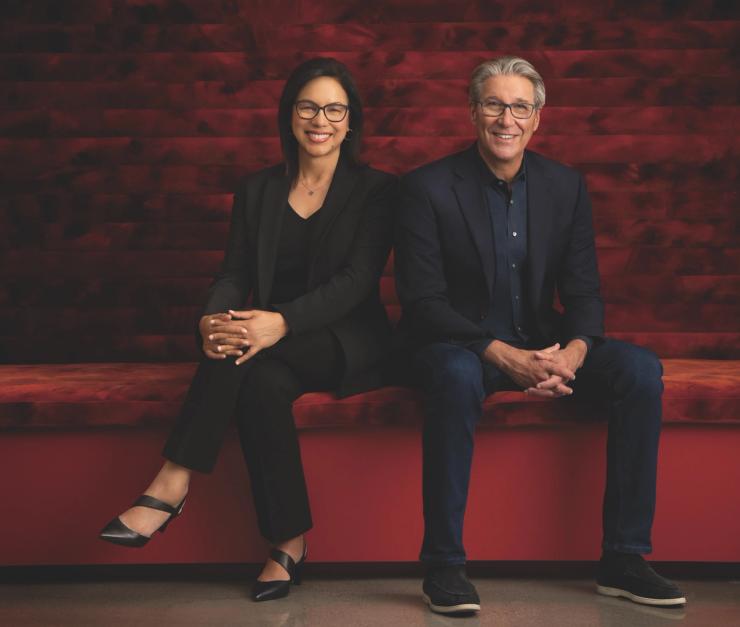The Signal Insight
Corporate history is littered with examples of executives being asked to share power, only to end up at each other’s throats. Co-CEO arrangements have been tried at companies like Deutsche Bank, Salesforce, and SAP, and then abandoned — often because of tension at the top.
The model persists in companies as large as KKR, Netflix, and Vontobel, and many banks still appoint co-heads to senior roles outside the C-suite. But few companies have been as committed to “co-leadership” as Gensler.
The world’s largest architecture firm, whose projects have ranged from the Shanghai Tower to Nvidia’s corporate campus, has co-chairs, co-CEOs, and co-heads of every practice area. Gensler, with 57 offices around the world, is owned by its 6,000 employees, but Diane Hoskins and Andy Cohen maintain that this model has been critical to its growth.
The pair succeeded co-founder Art Gensler and spent 20 years as co-CEOs, in which time its revenues expanded from about $300 million to $1.88 billion. Last year, they became co-chairs, “stepping out of the tyranny of the urgent” to focus on shaping the firm’s long-term vision, in Hoskins’ words. And they handed the reins to two successors: Elizabeth Brink and Jordan Goldstein. With two leaders sharing one role, Cohen argues, “you get three times, five, 10 times the value.”
This interview has been condensed and edited for clarity.
Andrew Edgecliffe-Johnson: Why does Gensler split such an important role between two people?
Andy Cohen: Art Gensler led our firm for about 25 years, and no one person could replace Art. So we, together, came up with the strategy of a collaborative leadership model. Everyone has aces and spaces — things that people are great at and they’re not so great at. But when you combine the aces of people together, the things they’re phenomenal at, the sparks fly, and innovation happens, and great ideas happen, and creativity happens. It’s like a leadership multiplier, instead of duplication.
What do you think is most important to making a shared role work?
Diane Hoskins: It’s trust and shared values. I can finish Andy’s sentences on these kinds of issues, and he can finish mine, but then [we have] tremendous differences as well. Andy comes from leading from the design seat, while I come from leading from more the management strategy side. So there are places where we’ve got super depth, where one plus one equals five. And then there are places where we are entirely different. Where other companies get it wrong is they think they need to have two people who are so similar that they’re just going to always end up in the same decision point. Why would you have two people if they’re the same? The point of [having two] people is to bring the breadth that one person can’t bring.
What are the mechanics? Do you have regular meetings?
Hoskins: [As co-CEOs], we’d have two calls each week where we’d have an agenda of 20 or 30 things we wanted to make sure we went through in a very disciplined way. And we developed this “on-point” chart [where we’d say], “For the next two years, you’re on point on this [subject].” Then we would trade, and for the following two years, the other one would be on point, whether it’s for finance, marketing, or one of our practice areas. So we made sure one of us was paying specific, clear attention. But also we made sure we were learning and going deep in all the topics that were important — and that we didn’t over-index, either of us, on any area.
So do you two always get along?
Cohen: I can’t remember a time when we’ve had an argument. Do we disagree? Do we have different points of view? Absolutely. But the trust and respect cuts through all that, and eventually we have to make a decision. One of us will say, “You know what, I hear you. I don’t agree with you, but go with it.” When there are disagreements or we are at loggerheads, we’re always going to ask, “Does that fit our vision for where we are going as a firm?” And that tends to calm the whole conversation down.
How often have you seen co-leaders clash?
Hoskins: I haven’t seen many times where it doesn’t work, because the role is to make the co-leadership model work. Your job isn’t to undermine your partner and then come whine to us and say, “It’s their fault that everything is falling apart.” We work hard at how we select people. We probably obsess on that more than other folks. Building leadership is fundamental to our business. We train, we coach, we know our leaders. So [when] we make these decisions, it’s with a lot of insight around what works.
Do you see any risks or downsides in the co-leadership model?
Cohen: If you don’t have the trust, it’s not going to work. If you don’t have a collaborative model, it’s not going to work. Frankly, we think the opposite. We don’t understand how firms can operate a non-collaboration [model]. It’s amazing how much ground you can cover in a collaborative leadership model.
Hoskins: I don’t want to say anything about companies that are run by one person. But most firms in our profession are one-person-led firms, and it [can] be too much about that person, and a bit of a cult of their thoughts and ideas.
We feel like speed is the thing that we are all going to be rewarded for. You can’t manufacture time, but you can — through having two CEOs or two managers — basically have 48 hours in a day instead of 24. So you’re kind of increasing the speed through having that dual-leadership model. I think it is the future. I really don’t think things are getting simpler. I think they’re getting more complex. And you’ve got to be able to see around the corner, and this helps.
Notable
- The co-CEO approach hasn’t always been a successful one. So it was a surprise when Netflix resurrected it in 2020, appointing Ted Sarandos and Reed Hastings to the role.
- The most recent example of a co-leadership structure came just this week, when Ubisoft appointed two executives as co-CEOs of a new subsidiary. One of them is the son of the company’s chief executive, who says: “What matters now isn’t my name, but the work ahead.”
- In the Harvard Business Review, leadership coach David Lancefield outlines seven key strategies to make the co-leadership model work — which include having a shared ambition and asking each other for advice.


